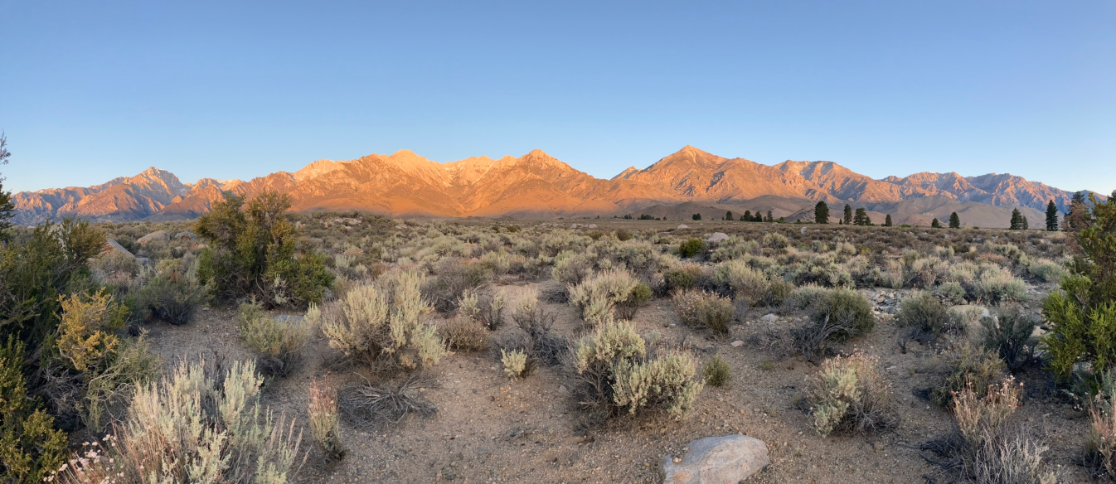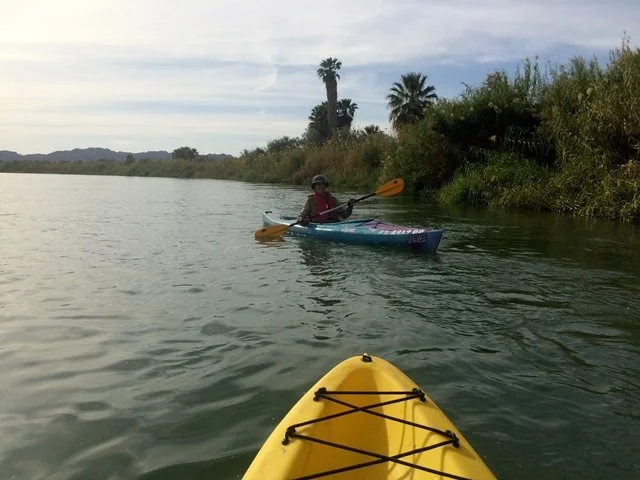The Lower Colorado River Project, 2015
/On a cool March morning in Lake Havasu City, a trickle of biologists in khaki pants and button-up shirts began very slowly to converge on a hill at the north end of the practice plot for the Lower Colorado River Riparian Bird surveys. The team of 14 had spent the morning in pairs, brushing up on their bird territory mapping, discussing flight calls of Lucy’s Warblers and White-crowned Sparrows, and sharing tips and tricks picked up in past years. Nearly all of the team consisted of returning crew members, and even the “newbies” had worked in the area before. At the little hill at the north end of the plot, an Arizona Bell’s Vireo was singing its burry, rambling song. Pencils scratched on plot maps, and clipboards were exchanged as the surveyors compared their distance estimates for this focal species.
Once everyone felt good with their practice survey, the group hiked down to the big set of hills by the lake, where wildflowers were abundant with the spring rain, and Ajo lilies were sprouting up like grass. The khaki army lined up at the top of the hill for a group photo, quickly adopting our goofiest poses; this field season was feeling like a reunion that would run for three months, through mosquitos and tamarisk swamps, cottonwood-willow riparian forests, sunrises, snakes, singing coyotes, and of course, birds!
Since we had such an experienced team this year, we were able to cut down somewhat on training and focus more on trail clearing, which would be beneficial since we had some tough plots to cover! Our 80 systemwide plots are selected randomly every year, stretching from Hoover Dam to the international border with Mexico. Our early season trail clearing and scouting efforts ensure that the surveyor will have access to survey each plot. For some areas, this just means driving out on farm roads and writing up directions. Other times, we’ve been known to spend two days on a plot with the entire crew clearing!
Our days in Lake Havasu City seemed to fly by, except for a select few thick tamarisk plots on Havasu National Wildlife Refuge, and some memorable days clearing and hiking on the Bill Williams River, where we spent most of our clearing effort. We even checked out an area of the latter where GBBO hadn’t ventured in years, a beautiful riparian strip at the end of Johnson Ranch Road. Soon, though, we were headed to Imperial National Wildlife Refuge north of Yuma, where we had more plots than usual, and they tend to be nasty ones. The first day lived up to expectations, with some members of the team wondering if they’d be eaten first by the swamp or by the clouds of mosquitos! With the latter disturbing the peace even at our usually pleasant campsite, there was some will among the crew to push hard and finish up the Yuma plots in two days. To their credit, these rubber-booted pioneers managed to work hard through two days and finished all the plots well ahead of schedule! This left us plenty of time to relax next to the river at our Blythe field house and knock off the last few plots in Blythe, mostly blissfully simple ag fields (but with one very difficult plot reminding us that it couldn’t be that easy!).
With training and trail clearing finished comes the time to divide up into our three field houses, in Havasu, Blythe, and Yuma. This is always a bittersweet time, knowing that we won’t be all together again until the end of season party. At the same time, everyone was eager to start finding birds, and more than a few were ready for their own rooms and beds!
In addition to the usual bird-filled Bill Williams surveys and scattered tamarisk-and-arrowweed surveys elsewhere, the Havasu crew surveyed an area south of Needles that is soon to be restored into a backwater for native fishes by the Bureau of Reclamation (BOR). It’s not much now, mostly sand dunes with pockets of, well, tamarisk and arrowweed, but it will be exciting to see the place transformed into a vibrant marsh lined with native trees.
The Blythe crew spends most of their time in the cottonwood-willow-mesquite forests that have already been planted by the BOR in that area. While many of those surveys are quieter than native habitats, one benefit of surveying in Blythe is getting to watch the birds go about their breeding season. The Blythe crew diligently studied calls, behaviors, and nests of their breeding birds whenever they could, for their own learning and to share their knowledge with the rest of the team. Many times the other crews will turn to the “Blythers” when they have a question, like this strange squeaking call made by a female Blue Grosbeak, actually a call soliciting copulation! Video by Jarrod Swackhamer.
As for the two-person Yuma crew, they surveyed a wide variety of plots, from created habitat at Yuma East Wetlands, to desert washes and quiet agricultural fields, to those impossible flooded tamarisk forests at Imperial NWR (which were also full of birds!). That area also had a good number of kayak plots this season. Kayak plots are often difficult but very rewarding, a morning’s adventure out on the water with the air full of the chatter of Marsh Wrens and the clacks and hoots of Least Bitterns. One morning in the marsh, Andrew was watching a few migrant Wilson’s Warblers foraging on a floating weed mat. Suddenly a huge carp burst out of the water, and a warbler at the edge of the mat disappeared, swallowed by the big fish!
Once surveys get started, everything turns into a blur of birds, maps, colored pencils, and computer screens. Long days of data cause more fatigue than 2:30 a.m. alarm clocks, and occasionally the well-oiled machine gets caught up on a flat tire, a forgotten gate key, or a stick in the road managing to break the truck. But when the sun is rising at 5:45, the cool breeze is playing in the cottonwood leaves, and you’re all alone with the trees, the water, the desert, and your birds, nothing else seems to matter. We’d like to express our appreciation and admiration to our surveyors who have faced these challenges year after year and keep coming back, because where would the LCR Project be without its amazing crew members?
- Lauren













